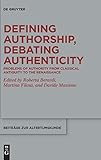Defining Authorship, Debating Authenticity : Problems of Authority from Classical Antiquity to the Renaissance / ed. by Roberta Berardi, Martina Filosa, Davide Massimo.
Material type: TextSeries: Beiträge zur Altertumskunde ; 385Publisher: Berlin ; Boston : De Gruyter, [2020]Copyright date: ©2020Description: 1 online resource (IX, 339 p.)Content type:
TextSeries: Beiträge zur Altertumskunde ; 385Publisher: Berlin ; Boston : De Gruyter, [2020]Copyright date: ©2020Description: 1 online resource (IX, 339 p.)Content type: - 9783110684551
- 9783110684667
- 9783110684629
- PN144 .D44 2021
- online - DeGruyter
- Issued also in print.
| Item type | Current library | Call number | URL | Status | Notes | Barcode | |
|---|---|---|---|---|---|---|---|
 eBook
eBook
|
Biblioteca "Angelicum" Pont. Univ. S.Tommaso d'Aquino Nuvola online | online - DeGruyter (Browse shelf(Opens below)) | Online access | Not for loan (Accesso limitato) | Accesso per gli utenti autorizzati / Access for authorized users | (dgr)9783110684629 |
Frontmatter -- Acknowledgements -- Contents -- Introduction -- Part 1: Attribution -- Semonides or Simonides? A Century–Long Controversy over the Authorship of a Greek Elegiac Fragment -- Greek Readers’ Digests (Again)? Some Lysianic ὑποθέσεις on P. Oxy. 31.2537 -- Defining a ‘Pseudo–Plato’ Epigrammatist -- Distinguishing Homonymous Writers, Detecting Spurious Works: Demetrius of Magnesia’s On Poets and Authors with the Same Name -- ‘On Sail–Flying Ships Did I Roam the Great Sea…’: The Epitaph of an Anonymous Merchant from Brundisium -- When the Author Is Not Identifiable: The Case of the Volcei Land– Register -- Part 2: Authorship -- Theognis the Author, Traditional Wisdom, and Some Side Effects of Authority -- Beyond the Scribal Error: Clues on the History of Philodemus’ On Rhetoric, Book 1 -- The ‘Co–Authorial’ Role of Ancient Pupils, Excerptores, and Copyists in the Genuinely Menandrean Γνῶμαι μονόστιχοι -- ΛΑΒΕ ΤΗΝ ΓΡΑΦΗΝ! Book Format, Authority, and Authorship in Ancient Greek Medical Papyri -- Defensio Bessarionis: Giorgio Benigno Salviati and the Concept of Authorship in Cardinal Bessarion’s Circle -- Part 3: Authenticity -- Can Virtue Be Taught? -- Reshaping Socrates’ Authority in the Pseudoplatonica -- Letter 1 of Demosthenes and the Prayer to the Gods -- The Second Epistle of Peter: A Different Approach to Lexical Analysis -- Forged Inscriptions in Early Epigraphic Corpora -- Bibliography -- List of Contributors -- Index
restricted access online access with authorization star
http://purl.org/coar/access_right/c_16ec
This volume explores the themes of authorship and authenticity – and connected issues – from the Classical Antiquity to the Renaissance. Its reflection is constructed within a threefold framework. A first section includes topics dealing with dubious or uncertain attribution of ancient works, homonymous writers, and problems regarding the reliability of compilation literature. The middle section goes through several issues concerning authorship: the balance between the author’s contribution to their own work and the role of collaborators, pupils, circles, reviewers, scribes, and even older sources, but also the influence of different compositional stages on the concept of ‘author’, and the challenges presented by anonymous texts. Finally, a third crucial section on authenticity and forgeries concludes the book: it contains contributions dealing with spurious works – or sections of works – , mechanisms of interpolation, misattribution, and deliberate forgery. The aim of the book is therefore to exemplify the many nuances of the complex problems of authenticity and authorship of ancient texts.
Issued also in print.
Mode of access: Internet via World Wide Web.
In English.
Description based on online resource; title from PDF title page (publisher's Web site, viewed 28. Feb 2023)


